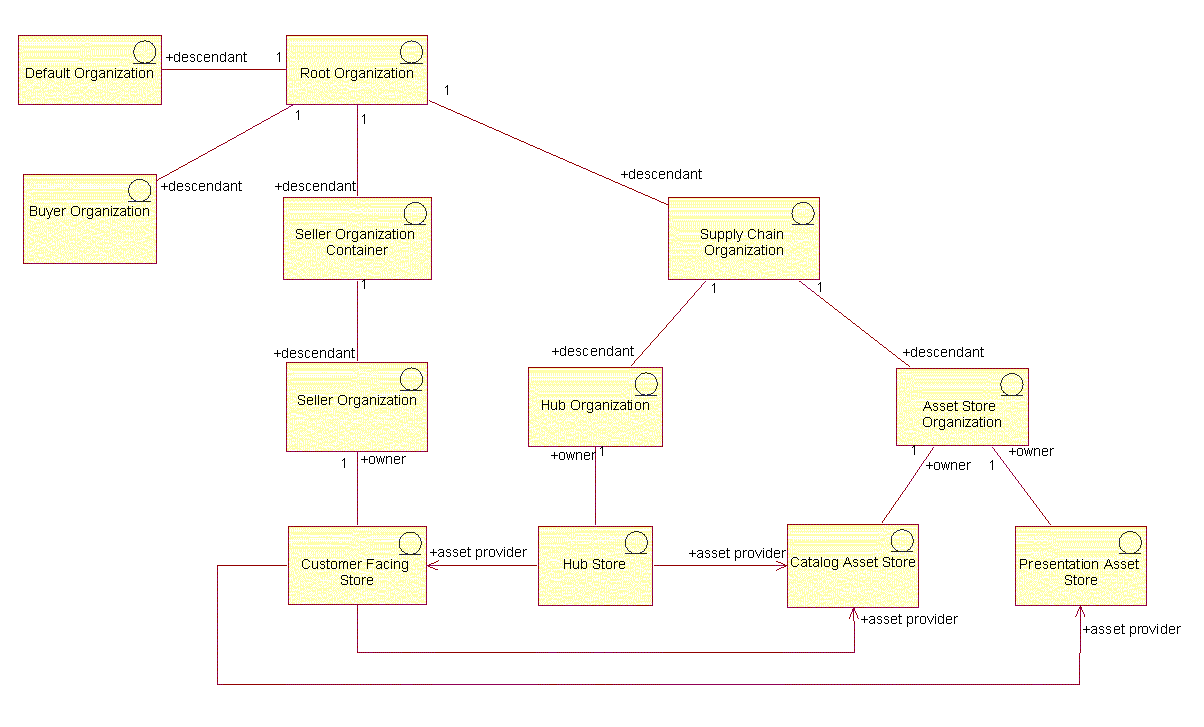Supply chain information model
Supply chain, one of the predefined models in WebSphere Commerce, is composed of the enterprises that provide services to a business. WebSphere Commerce provides the architectural infrastructure to support supply chains that take the form of a private marketplace, as well as through supplier sites.
A private marketplace provides a forum for vendors to offer their goods and services for sale. Buyers enter this forum and after browsing through the available options, select the appropriate goods or services.
The following diagram shows a UML representation of the supply chain information model.

- Root Organization
- All organizations in the business become descendents of the root organization. As well, the administrators who will maintain the online site, the Site Administrators, are added directly under the root.
- Default Organization
- Customers who do not register as part of a buyer organization, but as individuals, belong to the default organization.
- Buyer Organization
- Customers, known in B2B direct businesses as buyers, are represented by a buyer organization in the B2B organization structure. Individual users who belong to buyer organizations, must register under their respective organization.
- Supply Chain Organization
- The supply chain management organization is created to own all of the supply chain related organizations (with the exclusion of the organization that owns the suppliers).
- Seller Organization Container
- A Seller organization container holds any number of seller organizations. By having stores under different seller organizations, you have more flexibility in terms of access control for customers as well as administrators.
- Seller Organization
- The seller organization is created to own all of the stores. A child organization unit is created for each store.
- Customer Facing Store
- An online site where users may obtain information regarding products, and conduct business transactions over these products. Business transactions may include retail purchases, transactions between businesses and transactions between a government organization and citizens or businesses. WebSphere Commerce uses the generic term 'store' to describe the online space where all of these business transactions take place.
- Hub Organization
- A child organization of the Supply Chain Organization. The hub organization is created to own the supply chain hub. The administrators who maintain the supply chain hub's functions, as well as administering the supply chain organization, are termed channel administrators and are owned directly by the supply chain hub organization.
- Hub Store
- A store which enables partners or clients. In the supply chain business model the hub store could be a store directory.
- Asset Store Organization
- A child organization of the supply chain organization. The asset store organization is created to own all assets that are used to create stores.
- Catalog Asset Store
- A catalog of goods for sale, containing pricing and currency information.
- Presentation Asset Store
- The Presentation Asset Store consists of Web assets such as HTML pages, JSP files, style sheets, images, graphics and other multimedia file types. You can also define shipping methods, shipping charges, marketing promotions, and contracts assets.
Related concepts
Related reference